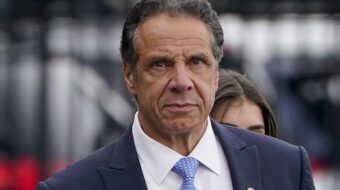WASHINGTON—Leading economists told the Senate, Mar. 30, that more, not less federal funds are needed to create millions more jobs to pull the nation out of the deepest recession since the Great Depression. They warned that a timid, limited federal response or terminating these federal job-creating programs too early could plunge the nation into an even deeper and more prolonged crisis.
Testifying before a Senate hearing, “Lessons of the Great Depression” convened by Sen. Sherrod Brown (D-OH), President Obama’s chief economic adviser, Cristina Romer, said President Franklin D. Roosevelt’s fiscal stimulus program was very small given the enormity of the economic collapse. Federal deficit spending did not bring full recovery “not because it does not work but because it was not tried,” she said.
Roosevelt’s New Deal was producing a gradual economic recovery after 1933, she continued. In 1937, the government reduced deficit spending and the banks tightened credit. The economy plunged again, unemployment soared, and the Depression lasted another two years.
President Obama “took this lesson to heart,” she said. “The American Recovery and Investment Act, passed by Congress less than 30 days after the Inauguration is the biggest and boldest countercyclical fiscal action in history.” The nearly $800 billion fiscal stimulus is divided between tax cuts and direct government investment spending and “aid to the states and people directly hurt by the recession,” she said.
While Roosevelt’s stimulus was only 1.5 percent of Gross Domestic Product, she added, Obama’s package is about 3 percent of GDP in each of the next two years.
“We expect this fiscal expansion to be extremely important to countering the terrible job loss” she continued. The “cautionary tale” of the 1937 plunge is to make sure the economy is fully on the road to recovery “before the government takes away the crucial lifeline,” she concluded.
University of Texas economist James K. Galbraith echoed her warning. The plunge in 1937 shows that “backtracking can be disastrous.”
Galbraith stressed that the “Great Crash” of 1929 “eliminated the possibility that recovery could be led by a revival of the financial system.”
There is no “easy or swift way back to rapid credit expansion,” he said. “And the path is slower and more difficult if policy energies are devoted to futile attempts to revive a ‘Paradise Lost,’ an economy led and directed by private commercial bank interests.”
Transfusions of banks with huge infusions of taxpayer funds “are likely to meet the same disappointments” today as in the early 1930s, he said. None of the witnesses proposed a public takeover of the mostly insolvent banks.
But Galbraith testified that the main lesson of the New Deal was the creation of “comprehensive social insurance (such as Social Security) and the construction of institutions for collective action, including trade unions.” Another is the need for massive investments in long-term infrastructure to lay the ground for strong economic growth.
He debunked right-wing economists – some of them fellow witnesses in the hearing – who argue that the New Deal failed. Some even refused to count those enrolled in the Works Progress Administration (WPA) or the Civilian Conservation Corps (CCC) as “employed.” The only “real” job, for them, is employment in private enterprise, he said.
New Deal programs created 3.5 million jobs and joblessness fell from 25 percent in 1933 to 9 percent in 1936 largely because of these programs.
Galbraith quoted economist Marshall Auerback on the achievements of WPA and the CCC: “The government hired about 60 percent of the unemployed in public works and conservation projects that planted a billion trees, saved the whooping crane, modernized rural America, and built such diverse projects as the Cathedral of Learning in Pittsburgh, the Montana State Capitol, much of the Chicago Lake Front, New York’s Lincoln Tunnel and Triborough Bridge complex, the Tennessee Valley Authority, and the aircraft carriers Enterprise and Yorktown.”
The New Deal built or renovated 2,500 hospitals, 45,000 schools, 13,000 parks and playgrounds, 7,800 bridges, 700,000 miles of roads and 1,000 airfields. It employed 50,000 teachers and hired 3,000 writers, musicians, sculptors, and artists.
Yet Lee Ohanian, an economist at UCLA told the hearing these New Deal programs “delayed economic recovery by impeding the normal forces of supply and demand” adding, “Wages rose even higher following the Wagner Act in 1935 which greatly increased union bargaining power…and which also facilitated unionization.” During the mid-1930s “sit-down strikes in which workers occupied factories…was used most notably against General Motors and the threat of a sit-down strike was used successfully against U.S. Steel.”
Wage increases he claimed were a major factor in the “1937-38 contraction.” He hailed the Supreme Court decision outlawing the sit-down strike and enactment of the Taft-Hartley law after WWII which he said, “substantially weakened” worker bargaining power.
Galbraith sharply rebutted these “free market” Reagan-Bush arguments. If higher worker pay was the cause of job loss, he asked, why did the economy collapse in 1929 when workers enjoyed none of the New Deal protections? Why is the unemployment rate so much lower in nations such as Sweden with a unionized high-wage workforce while nations with low wages suffer higher jobless rates?
Galbraith scorned economists who argue that “unions and the minimum wage increased unemployment” that “farm price supports were wasteful and inefficient” that “Social Security discouraged savings.” New Dealers had a simple answer, the alternatives to these measures were “poverty, migration, and early death” he concluded.









